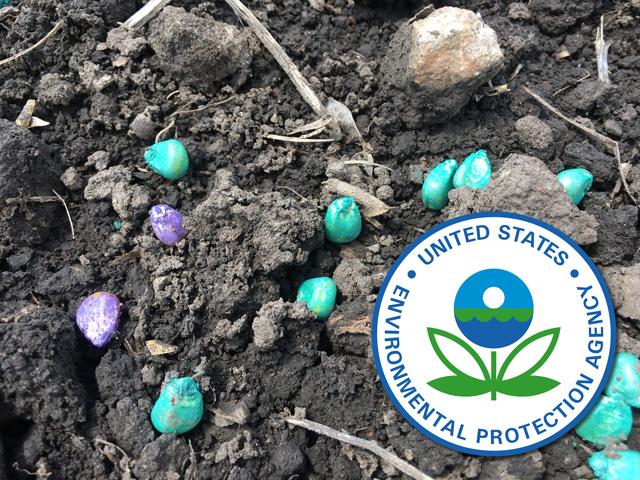Lawsuit Targets EPA Treated-Seed Regs
Environmental Groups' Lawsuit Seeks Regulation of Pesticides-Treated Seeds
LINCOLN, Neb. (DTN) -- Environmental groups asked a federal court on Wednesday to force the EPA to close what they say is a loophole in agency regulation that allows seeds treated with pesticides to go unregulated. The lawsuit was filed in the U.S. District Court for the District of Northern California.
The Center for Food Safety and Pesticide Action Network North America asked the court to declare the EPA in violation of the Administrative Procedure Act when it declared seeds coated with pesticides as treated articles exempted (TAE) from the same regulations required of pesticides.
The EPA in September 2022 rejected a 2017 petition filed by the groups asking the agency to regulate coated seeds. That was done after a court order.
The groups outline in the lawsuit how they believe EPA is mistaken in its classification of pesticide-coated seeds.
"EPA rests its petition denial on the claims that, not only are the seed and plant an 'article' under the exception, but the seed and living plant are the exact same article," the lawsuit said.
"According to EPA, because a seed (the 'article' treated) becomes a living plant, protection beyond the seed itself and the presence of neonicotinoids in the living tissues of the whole plant does not negate the application of the TAE. Thus, for EPA's interpretation in the denial to make logical sense, it would have to equate the seed and the whole plant, as EPA has stated in numerous places that only articles treated for the sole protection of the article itself may be exempted under the TAE."
EPA implemented regulations establishing treated article exemption in 1988.
Seeds treated with neonicotinoids are at the center of environmental contamination being cleaned up by seed companies at a former ethanol plant in Mead, Nebraska, a town of 569 residents about 40 miles north of Lincoln.
SEEDS, PLANTS LIVING ORGANISMS
P[L1] D[0x0] M[300x250] OOP[F] ADUNIT[] T[]
The groups said the seeds and plants are "living organisms," which is different from other products deemed as articles not covered by pesticide regulation.
"Because neonicotinoids are primarily applied to coated seeds to protect the growing plant -- not the seed -- from pests, coated seeds are not treated with pesticides solely to protect the 'article,' aka the seed," the lawsuit said.
"To equate the seed, which is living and part of the larger plant, with a whole living plant that is thousands of times larger, does not find support in either common sense, or the canons of construction. Finally, the vast majority of the seed coating does not remain on the seed and thus does not protect it as a coating as the TAE exemption intends."
The three major members of the neonicotinoids class are imidacloprid, thiamethoxam and clothianidin, registered by EPA in 1994, 2000 and 2003, respectively.
Bayer and Syngenta are the two largest producers of pesticide-coated seeds in the U.S.
Bayer declined to comment when contacted by DTN.
USE EXPLODED IN US WITHIN 10 YEARS
Neonicotinoids use in the U.S. has exploded from about 1.4 million pounds in 2004 to about 7.9 million pounds in 2014, according to the lawsuit.
Seeds coated with neonicotinoids were planted on about half of all U.S. crop acres in 2012, the lawsuit said. That includes about 90% of all corn from 2012 to 2014. About 95% of the neonicotinoids in seed coatings are typically lost to the environment, according to the groups.
The lawsuit also challenges models used by EPA to decide which products to exempt from pesticides regulation.
"Yet even though seed treatments represent roughly 90% of total neonicotinoid use and 95% of seed coatings are lost to the environment, EPA's models tell it that the remaining 10% of neonicotinoid use (comprising of soil and foliar applications) accounts for substantially more runoff," the lawsuit said.
"This apparent paradox is explained by the fact that EPA's modeling assumes that none of the neonicotinoid on treated seeds planted deeper than 2 centimeters (0.8 inch) runs off, because this places the pesticide-coated seed below the 2-cm runoff extraction zone of the model."
The lawsuit continues, "If the model predictions were correct, there would be virtually no clothianidin in Iowa streams, because nearly all the clothianidin used in the state is applied to corn seeds, which are planted at an average depth of more than 2 centimeters, below the model's 'runoff extraction zone.' Yet as noted above, this neonicotinoid is in fact found in 75% of Iowa stream and river samples, often at levels injurious to aquatic life."
Read more on DTN:
"EPA Rejects 2017 Treated-Seed Petition," https://www.dtnpf.com/…
"Seed Companies Volunteer to Clean Up Mead," https://www.dtnpf.com/…
Todd Neeley can be reached at todd.neeley@dtn.com
Follow him on Twitter @DTNeeley
(c) Copyright 2023 DTN, LLC. All rights reserved.






